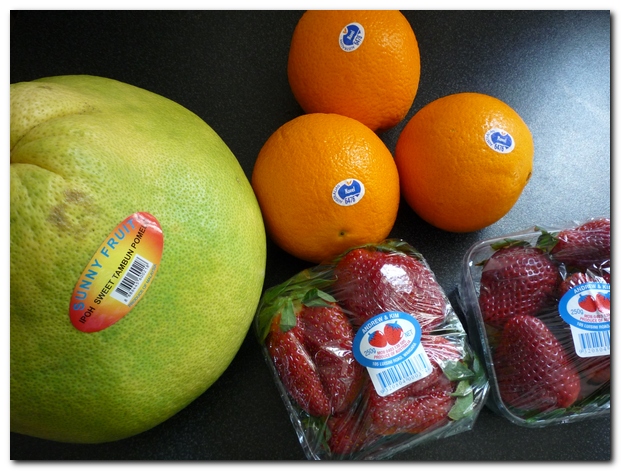 One new mindset which I have adopted whenever I go marketing is to buy fruits when they are in season. Fruits simply taste better and are cheaper in season.
One new mindset which I have adopted whenever I go marketing is to buy fruits when they are in season. Fruits simply taste better and are cheaper in season.
Take for example, blueberries. When in season, you can get 2 punnets for $4.90 at NTUC. On other days, 1 punnet will cost around $7+. I enjoy baking blueberry butter muffins – for the delicious aroma released during baking and also for the lovely purplish-green color of the berries set in the muffins. The bite of a freshly baked, warm blueberry muffin is sooo heavenly. The blueberries were also refreshingly sweet when eaten fresh.
Another recent example is persimmons. There are 2 types – Fuyu and Hachiya. I bought a bag of Korean Fuyu persimmons from NTUC last week and have been savoring its sweetness, crunchiness and mellow-peachy flavour at one fruit a day. I read somewhere that it is better to peel off its skin as it may cause some digestive problem. Apart from that, it is a good source of potassium, vitamin C and beta-carotene.
Of late too, I noticed that NTUC also carry Shingo pears from Korea. I was so delighted! Too often, NTUC only carries Asian pears from China and this left me with no other options. I totally boycott China’s produce even it means to forgo our favorite fruits (Yang likes Asian pears). BTW, Korean Shingo pears are a definitely cut above China’s. They cost a few cents more but are sweeter, juicer and bigger (one Korean Shingo pear can satisfy two adults) with a healthy core.
I have come across too many China pears and also ‘Fuji’ apples with bland tasting flesh and rotten cores. Just this week, NTUC is also selling Ohrin apples (this is super sweet – too sweet for my taste buds) and Seiki pears from Japan at affordable prices.
Oh yeah, before I end off, I’d like to add a little note about corn on cob. I used to believe that the Japanese bicoloured corn is the best. After doing some reading up on corns, I experimented on other corns produced in Malaysia and Thailand.
My current practice about purchasing corn: buy cheap corn on cob with bright green sheaths or ‘ears’ and fresh-looking silk (if still unsure, smell the silk – there shouldn’t be any stench). The fresher the corn, the sweeter it will be when cooked. It seems that Malaysia’s corns are sweeter and more tender than Thailand’s varieties sold here. Corn, when harvested, will start the process of converting sugar to starch. Hence, an ‘old’ corn will taste starchier. So, if the corn comes from a distant land, chances are that it has lost much of its sweetness.
Of course, once the corn is bought, cook it asap la. I like to boil it in water: put corn in a pot and cover it with water, bring to a rolling boil, let water boil the corn for 10 mins, take the corn out, use a fork to secure one end of the cob and with a knife slice the kernels off the cob onto a plate, add 1/2 tbsp of butter and mix well. Enjoy! :D
now is korean strawberries season!!! i got a punnet for $5.50 so cheap for korean! ^^ sweet sweet =)
Ann, where did you buy the korean strawberries? Cold storage? I like strawberries too!
Ling, from where did the pear you served earlier this year come? Was it a Korean pear?
In Nov. ’06 you’d served a Chinese pear that I thought was very, very good. (In fact, from that point on I’d been craving pears, but never found one that was its equal.) It’s too bad about the inconsistency, which must be frustrating.
Hi Matt, both times were China pears. Just so happened that they were of the better lot. You must try the Korean Shingo pears. They were still better than those you have tasted! :)